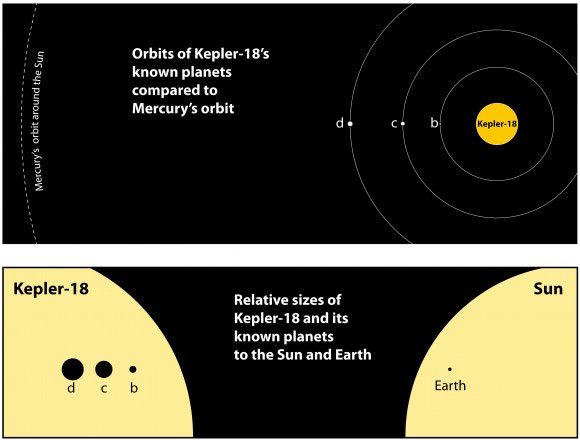
The top graphic shows the orbits of the three known planets orbiting Kepler-18 as compared to Mercury's orbit around the Sun. The bottom graphic shows the relative sizes of the Kepler-18 and its known planets to the Sun and Earth. Credit: Tim Jones/McDonald Obs./UT-Austin
What has a super-Earth and two Neptune-like planets? This tempting dessert belongs to the latest Kepler discovery found orbiting Kepler 18. Bill Cochran and a team of researchers have found the resonance they were looking for… and this very Sun-like star may have even more planets dancing around it.
Kepler 18 is a prime candidate for a solar system. The host star is approximately 97% the Sun’s mass and only about 10% physically larger. For now, the transit method has detected three planetary candidates named b, c and d which orbit within a zone smaller than Mercury’s. The “Super Earth” is about twice our size and its year only last three and a half days. At about six times and seven times our size, gaseous planets c and d have rough orbital periods of seven and half and fifteen days respectively.
While the two larger planets have similar transits, their times “are not staying exactly on that orbital period,” Cochran says. “One is slightly early when the other one is slightly late, [then] both are on time at the same time, and then vice-versa.”
Scientifically speaking, c and d are orbiting in a 2:1 resonance. “It means they’re interacting with each other,” Cochran explains. “When they are close to each other … they exchange energy, pull and tug on each other.”
By using the transit method, the Kepler mission is able to watch for periodic brightness changes that signal orbiting bodies. Imagine a bright flashlight moving steadily behind a picket fence in the dark and you’ll get the picture. If each board were a slightly different size, the times the flashlight would be seen would vary. Resonance occurs – very simply put – when there’s a pattern like two wide boards and then a small one. But there’s more that can pass in front of our flashlight than just boards. There could be a line-of-sight star with a binary companion… and it’s just variables like these that makes confirming Kepler’s findings crucial.
In a process called “validation”, Cochran and his team utilized the Palomar 5-meter (200-inch) Hale Telescope and its adaptive optics to take another look at Kepler 18 and its system. “We successively went through every possible type of object that could be there,” Cochran says. “There are limits on the sort of objects that can be there at different distances from the star.” The findings were negative. The planetary trio survived the next stage of identification.
“There’s a small possibility that [planet b] is due to a background object, but we’re very confident that it’s probably a planet,” Cochran says. With a seven hundred times probability factor that the Kepler findings signify a planetary signature, chances are good this trio is going down on the records as a validated system – with perhaps more yet to be discovered.
“We’re trying to prepare the astronomical community and the public for the concept of validation,” he says. “The goal of Kepler is to find an Earth-sized planet in the habitable zone, with a one-year orbit. Proving that such an object really is a planet is very difficult. When we find what looks to be a habitable Earth, we’ll have to use a validation process, rather than a confirmation process. We’re going to have to make statistical arguments.”
Original Story Source: McDonald Observatory News Release.
Source: Universe Today
No hay comentarios:
Publicar un comentario